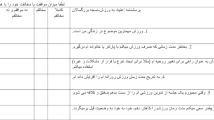Abstract
Although generally acknowledged as health enhancing, exercise has also been recognised as having the potential to become damaging. The most popular viewpoint has been that extreme exercising is a form of addiction. The current study was designed to provide an exploratory qualitative analysis of the themes underlying exercise behaviour. A total of 100 self-selected gym users were administered a questionnaire incorporating the Exercise Addiction Inventory [Terry, A., Szabo, A., & Griffiths, M.D. (2004)] and a number of open-ended questions. Results showed that 8% of the participants scored over 24 (out of 30) and were operationally defined as exercise addicts. The focus of this study was the addition of the qualitative open-ended questions exploring positive and negative experiences of exercise. These additional questions aided in making the distinction between committed exercisers and those at risk of exercise addiction clearer. Participants who were committed responded with understandable and functional psychological reasons for their exercise behaviour. Those who were identified as being at risk from exercise addiction indicated difficulties in other areas in their lives drove them to high and possibly dangerous levels of exercise.
Similar content being viewed by others
References
Bamber, D., Cockerill, M., Rogers. S., & Carroll, D. (2003). “It's exercise or nothing”: A qualitative analysis of exercise dependence. British Journal of Sports Medicine, 34, 423–430.
Brown, R. I. F. (1993). Some contributions of the study of gambling to the study of other addictions. In: W. R. Eadington & J. A. Cornelius (Eds.), Gambling Behaviour and Problem Gambling (pp. 241–272). Reno: University of Nevada Press.
Carr, D. B., Bullen, B. A., Skrinar, G. S., Arnold, M. A., Rosenblatt, M., Bietins, I. Z., Martin, J. B., & McArthur, J. W. (1981). Physical conditioning facilitates the exercise-induced secretion of beta-endorphin and beta-lipoprotein in women. New England Journal of Medicine, 305, 560–563.
Cox, R. (1999). A qualitative study of the meaning of exercise for people who could be labelled as ‘addicted’ to exercise—Can ‘addiction’ be applied to high frequency exercising? Unpublished clinical psychology doctorate thesis, University of Birmingham.
De Coverly Veale, D. M. W. (1987). Exercise dependence. British Journal of Addiction, 82, 735–740.
De Coverly Veale, D. M. W. (1995). Does primary exercise really exist? In: A. Cripps & J. Steinberg (Eds.), Exercise Addiction: Motivation for Participation (pp. 1–5). Leicester: The British Psychological Society.
De La Torre, J. (1995). Mens sana in copore sano, or exercise abuse? Clinical considerations. Bulletin of the Menninger Clinic, 59, 15–31.
Ewald, K., & Jiobu, R. M. (1985). Explaining positive deviance: Becker's model and the case of runners and bodybuilders. Sociology of Sport Journal, 2, 144–156.
Garman, J. F., Hayduk, M. D., Crider, D. A., & Hodel, M. M. (2004). Occurrence of exercise dependence in a college-aged population. Journal of American College Health, 52(5), 221–228.
Griffiths, M. D. (1996). Behavioural addiction: An issue for everybody? Journal of Workplace Learning, 8(3), 19–25.
Griffiths, M. D. (1997). Exercise addiction: A case study. Addiction Research, 5, 161–168.
Griffiths, M. D. (2002). Gambling and Gaming Addictions in Adolescence. Leicester: British Psychological Society/Blackwells.
Griffiths, M. D., Szabo, A., & Terry, A. (2005). The exercise addiction inventory: A quick and easy screening tool for health practitioners. British Journal of Sports Medicine, 39, 30–31.
Hausenblas, H. A., & Downs, D. S. (2002). How much is too much? The development and validation of the exercise dependence scale. Psychology & Health, 17, 387–404.
Hausenblas, H. A., & Fallon, E. A. (2001). Relationship among body image, exercise behaviour and exercise dependence symptoms. International Journal of Eating Disorders, 32, 179–185.
Hausenblas, H. A., & Symons Downs, D. (2001). How much is too much? The development and validation of the exercise dependence scale. Psychology and Health, 17, 387–404.
Hayes, N. (2000). Doing Psychological Research: Gathering and Analyzing Data. Buckingham: Open University Press.
Morgan, W. P. (1979). Negative addiction in runners. The Physician and Sportmedicine, 7, 57–71.
O'Dea, J. A., & Abraham, S. (2002). Eating and exercise in young college men. Journal of American College Health, 50(6), 273–278.
Ogden, J., Veale, D., & Summers, Z. (1997). The development and validation if the exercise dependence questionnaire. Addiction Research, 5, 343–356.
Orford, J. (2001). Excessive Appetites: A Psychological View of Addictions. West Sussex: John Wiley & Sons.
Pasman, L., & Thompson, J. K. (1988). Body image and eating disturbance in obligatory runners, obligatory weightlifters and sedentary individuals. International Journal of Eating Disorders, 7, 759–769.
Sachs, M. L., & Pargman, D. (1979). Running addiction: A depth interview examination. Journal of Sports Behaviour, 2, 143–155.
Terry, A., Szabo, A., & Griffiths, M. D. (2004). The exercise addiction inventory: A new brief screening tool. Addiction Research and Theory, 12, 489–499.
Thompson, J. K., & Blaton, P. (1987). Energy conservation and exercise dependence: A sympathetic arousal hypothesis. Medicine and Science in Sport and Exercise, 19, 91–99.
Thompson, J. K., & Pasman, L. (1991). The Obligatory Exercise Questionnaire. Behavior Therapist, 14, 137.
Yates, A. (1991). Compulsive Exercise and Eating Disorders: Toward an Integrated Theory of Activity. New York: Brunner/Mazel.
Author information
Authors and Affiliations
Corresponding author
Rights and permissions
About this article
Cite this article
Warner, R., Griffiths, M.D. A Qualitative Thematic Analysis of Exercise Addiction: An Exploratory Study. Int J Ment Health Addiction 4, 13–26 (2006). https://doi.org/10.1007/s11469-006-9000-5
Received:
Revised:
Accepted:
Published:
Issue Date:
DOI: https://doi.org/10.1007/s11469-006-9000-5




